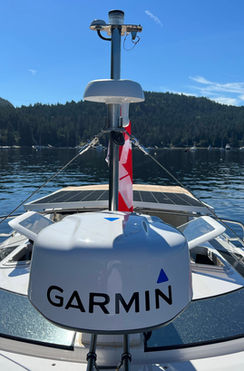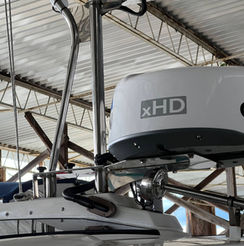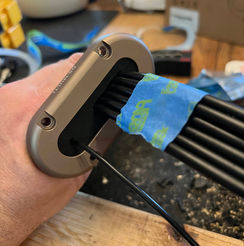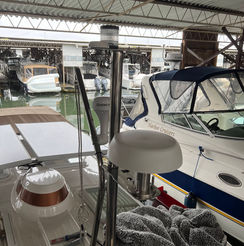
Internet-Cellular
Added 5G/LTE to the boat for 24x7 Internet at 6 watts of power draw.
I installed a Peplink MAX BR1 Pro 5G router with a Peplink Mobility 42G antenna on the boat.
I have benchmarked over 300mbs over 5G/LTE. I have two SIM cards, T-Mobile and ATT, for diversity. T-Mobile is faster than ATT in the San Juan Islands. ATT was the preferred carrier throughout Canada and SE Alaska for me. I had cellular service coming around Cape Caution, acorss the Dixon Entrance, out in front of Tracy Arm, some very remote places while my phone said "no service".
I removed the TV antenna that came with the boat as we don't watch a lot of TV. This is actually how our boat name "Channel Surfing" came to be. We'd rather be out channel surfing in our boat! (Presidents Channel, San Juan Channel, Swinomish Channel.. etc...). But we do watch a lot of YouTube (big surprise there!). We want to be able to watch YouTube on our boat. For folks who don't know, we also run a YouTube channel "Lets go channel surfing". Check out our channel if you haven't already.
This install required a lot of thought, planning, and research. I needed to keep the antenna out of the beam of RADAR, and I wanted it to have a 360 view all around which meant get above the RADAR dome.
I removed the TV/UFO antenna and used that spot to mount the LTE/5G antenna.I installed a Peplink Mobility 42G high gain antenna. Its a 7 in 1 antenna (4xLTE antennas, 2xWIFI antennas, 1xGPS ).
Since I was going to be running 7 cables, I added a Sirius XM antenna at the very top of the mast, by the anchor light.
I wanted to get the best possible LTE/5G signal I could get. If I extended the LTE and WIFI antenna cables I would lose A LOT of power to attenuation. I kept within the 6.5' (2meters) of antenna cable that came with the antenna. This meant I had to install the LTE/5G router as close to the base of the mast as possible. I have about 6 inches of antenna cable to spare. This is why the router is mounted upside down in the cabin.
I had to install a new clamshell on the boat to route 8 antenna cables through and make it waterproof. There was not enough room in the factory clamshell on the port side to add additional cables.
I had to make sure I ran the cables such that even though the new clamshell is on the starboard side, the mast is still able to easily fold down towards the port side for trailering. I routed all 8 cables through the mast for a nice clean look.
I am not retired and have been working from home since 2011. Now I can easily work from boat (WFB) which will allow us to spend more time on the boat and away from the dock.
The reason(s) I went this direction instead of Starlink are as follows:
I can have Internet when I'm doing 25 knots.
The Starlink Mobile plan does not support in-motion.
The 5g/LTE antenna is marine rated water-proof.
The Starlink Gen 2 mobile dish does not have a weather rating.
The power draw for the LTE/5G router is 6 watts.
Starlink is 45 watts.
LTE/5G is continually getting better. 5G is currently being expanded. Speeds above 100mbs are realistic. I'm an inter-coastal cruiser.
I bring out Starlink on occation when I need to move a lot of data or when I am simply out of reach of a cell tower. The LTE/5G router has a WAN port that I plug Starlink.
The mobility antenna re-shapes that cell signal to increase its power significantly allowing me to be further away and still maintain signal. The biggest problem with cell connectivity on a boat is the cell tower has lots of power to reach me, but my phone doesn't have the antenna or power to actually talk back to the tower. A high-gain antenna mounted high up on the mast considerably improves speed and connectivity and stretches that distance away from a cell tower.
I don't need cellular voice as voice calls are ran over the LTE/5G data connectivity. (Voice over LTE) So long as I have great data connectivity I'll have a fully functional phone. The high-gain antenna (Mobility 42G) is specifically designed to re-shape the antenna pattern, to flatten it out, increasing power by reshaping that signal more horizontally (towards land) instead of up into the sky. You can't necessarily increase power, but you can take the power you have and concentrate it in a specific direction. Think of a flashlight, as you adjust the beam of light from very wide to more focused you get a more intense beam of light pointing a specific direction.
For the San Juans Islands, T-Mobile is going to be your best bet. I spent the money for 5G as T-Mobile purchased the 600mhz frequency in 2017. In 2019 they started deploying it. Band 71 is unique to T-Mobile currently. They bought this frequency at auction against the other carriers specifically for rural America. The lower frequency is able to go farther than higher frequencies. With the newly acquired 600 MHz spectrum, which will broadcast as band 71, T-Mobile will be able to deploy far-reaching signals with greater bandwidth across the entire US.Having multiple SIM cards is also a requirement.
The Peplink MAX BR1 Pro 5G supports 2 SIM's but only has 1 modem. It can pick and choose which carrier to use based on current signal strength, as well as billing options (how much bandwidth you've used this month).
I have my Peplink configured to connect using the following priorities.
WAN Port - Starlink (if it's plugged in, use it).
2.4ghz WAN - Connect to Marina Guest WIFI
LTE/5G - Connect to cellular network on either SIM card.
When I plug in Starlink, the Peplink sees it and prefers Starlink over all others. When Starlink is disconnected it'll try for Guest Marina Wi-Fi. If that's not available then it'll use 5g/LTE via the SIM cards.
The Mobility 42G antenna offers the following gain per frequency range.
Note, 3dBi of gain doubles the power.
Cellular Frequencies
2.7 dBi: 617-960MHz
5.2 dBi: 1710-2700MHz
4.9 dBi: 3400-4200MHz
6.7 dBi: 5000-6000MHz
Note: These numbers represent without a ground plane, as it's impractical to install one on my boat.
WIFI Frequencies
5.0 dBi: 2400-2500Mhz
7.5dBi: 5000-6000Mhz
As I boat around the San Juan Islands I'm looking at various indicators of cell coverage. RSRP, RSRQ, SINR. If you have an iPhone, disable WIFI then dial this number: *3001#12345#* and it'll open up your LTE/5G stat's on your phone.
RSRP
>= -80 is excellent
-80 to -90 is good
-90 to -100 is mid-cell.
<= -100 is cell edge (poor).
RSRQ
>= -10 is excellent.
-10 to -15 is good.
-15 to -20 is mid-cell.
< -20 is cell edge (poor).
SINR
>= 20 is excellent.
13 to 20 is good.
0 to 13 is mid-cell.
<= 0 is cell edge (poor)
The Peplink MAX BR1 Pro 5G has a nice dashboard which also shows RSRP, RSRQ and SINR. This helps me better understand the cellular connectivity available at an anchorage. The reason we all struggle on the water with connectivity is that the tower has a lot of power to get that signal to you. But the power and antenna setup on our phones offers much less range on the return from the phone to the tower.
In addition to offering LTE/5G connectivity, the MAX Pro 5g offers WIFI connectivity to guest WIFI at marinas. We use this feature a lot actually. Save the data on our cell plans when moored as a guest at a marina and bring in marina guest WIFI to the boat via the high gain antenna.
What I installed on my boat
Pepwave Mobility 42G 7in1 high-gain antenna
I installed the Pepwave MAX BR1 Pro 5g to the ceiling, centerline. Screwed into the teak, upside down. Mostly as forward as it can go up there. I already had 12volt power there labeled as "spot light", which I don't have. But Ranger Tug was nice enough to at least run the 12volt power for a spot light and left the cable at the base of the mast, inside the boat, above the centerline teak. I re-labeled the wires to "WIFI/LTE" and downgraded the fuse to 2amps.
The original setup I started with:
Pepwave Mobility 22G 5in1 high-gain antenna
How much does a longer antenna cable extension affect performance?Signal strength is measured in decibels, which is based on a logarithmic scale. It's signal loss varies also based on the frequency of the signal. LTE covers a wide range of frequencies. The higher the frequency the greater the loss caused by longer cables.If you need to stretch the antenna cables, you want to go with the highest quality cable you can find and you want it to be as short as necessary. 1meter, 3meter, 5meter... The cable is also not that flexible and doesn't bend easily (nor should it be bent very much).It's a trade-off between getting that antenna up high on the mast and keeping that antenna length as short as possible. It's better to run longer power cables to the router and place the router closer to the antenna if possible. The longer that antenna cable goes, the less power available to transmit.
Here's some specifics examples.
The Peplink Mobility 42G comes with a 2meter cable.
Frequencies used in cellular and WIFI are:
600-960mhz
1427-1517mhz
1710-2170mhz
2300-2700mhz
5000-6000mhz.
600mhz (TMobile's Band 71)
2 meters0.6dB lossCable run efficiency: 88%
5 meters1.6dB lossCable run efficiency: 72%
7 meters2.3dB lossCable run efficiency: 62%
2500mhz (4g/LTE Urban band)
2 meters1.6dB lossCable run efficiency: 74%
5 meters3.4dB lossCable run efficiency: 50%
7 meters4.9dB lossCable run efficiency: 36%
When looking at the dB loss, keep in mind transmit power is 21 dbm at the LTE router.
The POYNTING extension cable for 7 in 1 antennas comes in a 3meter length and uses LMR-195 cable.
Here's an online calculator that does the math.
Last update: 1/5/2025






























